Day trading is the process where people buy and short financial assets like stocks and commodities. Professional traders combine various analysis approaches to identify entry and exit opportunities. These approaches are simplified into technical and fundamental analysis.
Technical analysis is an approach that involves using technical indicators and chart patterns to identify these positions. Fundamental analysis is more broad since it involves looking at key information like earnings, valuations, and economic data.
Drawing tools are an essential part in trading and analysis. In most cases, these tools are used to identify support and resistance levels and potential entry points. This article will look at some of the top drawing tools to use in trading.
Table of Contents
What is technical analysis?
Technical analysis is a process where a trader looks at charts to identify trading opportunities. It involves looking at patterns in a chart and then predicting whether an asset will rise or fall in a certain period.
There are two main types of chart patterns in trading: continuation and reversals. Continuation patterns mean that an asset will continue rising or falling while a reversal is a sign that an asset will start a new trend.
The other approach is using technical indicators, which are divided into lagging and leading. Lagging indicators like moving averages and the Bollinger Bands use historical data to predict the next price movement.
Leading indicators, like the McClellan Oscillator and McClellan Summation Indicator, use present information to predict the next price action.
What are drawing tools in trading?
Technical analysis works well when it incorporates drawing tools, which are useful in identifying support and resistance levels of an asset. A good example of these tools are in the chart below.
The chart below shows Tesla stock with a descending channel and a head and shoulders tool. These tools can show you the key levels of an asset to watch.
In this chart, a breakout is confirmed if the price moves above the upper side of the descending channel.
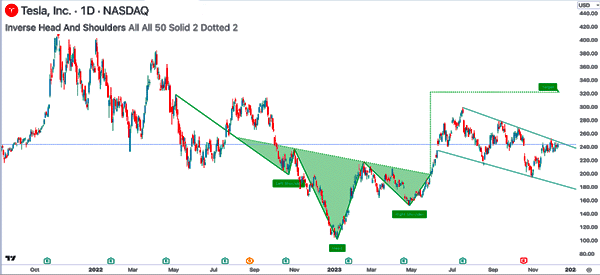
So, let us look at some of the best drawing tools in day trading.
Fibonacci Retracement
Fibonacci Retracement is one of the best drawing tools in the financial market. It is based on a complex mathematical calculation known as the Fibonacci sequence. The Fibonacci sequence is based on the idea that a number is the sum of two preceding ones.
The Fibonacci Retracement tool has several important numbers: 23.6%, 38.2%, 50%, 61.8%, and 78.6%. To draw it, traders join two high and lower swings and then observe these Fibonacci levels.
A good example of the Fibonacci Retracement tool is shown below. In this chart, we have connected the high of $415 and the low of $100.20.
Now, with the stock trading at $240, a bullish breakout is confirmed when the price moves above the 50% retracement point at $257.

The benefits of using the Fibonacci Retracement tool is that it is easy to use and is one of the best tools to identify support and resistance levels. It is also one of the most accurate tools to use in day trading.
Pitchfork
Pitchfork is another tool that can help you identify support and resistance levels. It is a channel tool that has five lines with the middle one being surrounded by two support and two resistance levels.
The pitchfork is added in a chart by first identifying three important swings. We can apply the pitchfork in the Apple chart above. In this, we identified the lower swing at about $100 and the initial peak at $299 and the lower swing at $194.
This chart implies that the stock is still in an uptrend as long as it is inside this pitchfork. More upside will be confirmed if it moves above the first support of the pitchfork tool.
Such a move will point more upside to its median one. The pitchfork can be drawn both when an asset is in an uptrend and when it is falling.
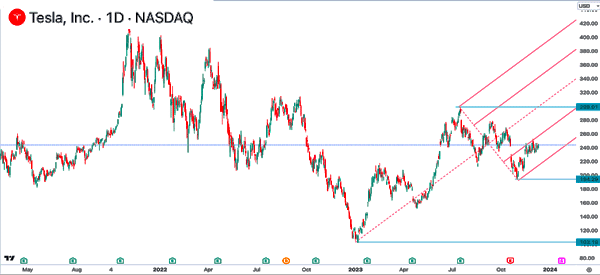
Trendlines
The most important concept in trading and investing is support and resistance. A support level is a price at which an asset fails to move below. It is seen as a floor of an asset. On the other hand, resistance is a price where an asset struggles to move above.
Therefore, trendlines are simple but important tools that you can use to find these support and resistance levels. These tools are provided by all charting platforms like MetaTrader, NinjaTrader, and TradingView.
In the chart below, we see that Google shares were in an uptrend. Using trendlines, however, it was possible to draw resistance and support lines, which formed a rising wedge pattern. In most periods, this pattern usually leads to a bearish breakout.

Trendlines can move in all directions. They can move both diagonally and in a horizontal direction.
Gann trading tools
The other trading tool that you can use is the Gann square, which was developed by William Delbert Gann. In addition to Gann Square, he also developed Gann Fan and Gann Box. These tools are based on the concept known as the Gann Theory, which is based on numerous Gann angles.
The benefit of using the Gann Square is that it is a good tool to identify support and resistance levels. It is also fairly easy to use.
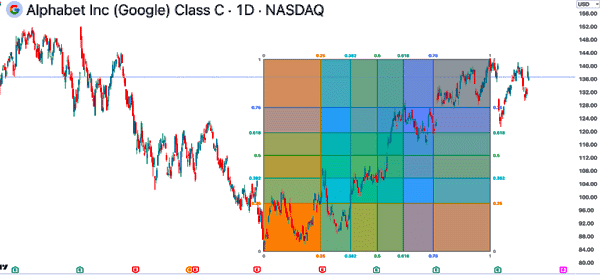
Channels and patterns
The other popular drawing tools in technical analysis are patterns. These patterns are divided into reversals and continuations.
Some of the most popular reversal chart patterns are:
- Head and shoulders
- Rising and falling wedges
- Double and triple tops
Continuation patterns include cup and handle and bullish and bearish flags.
These patterns can be drawn using the normal trendlines. However, some charting platforms like TradingView have these pattern tools built in. The chart below shows a double-top pattern in Evercore.
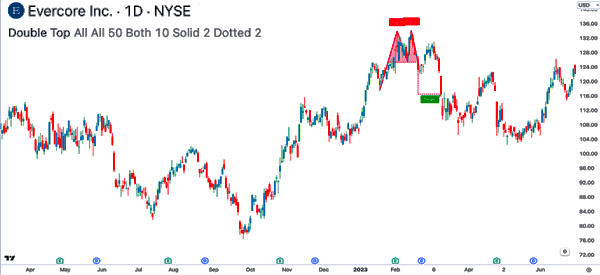
How can drawing tools help in technical analysis?
Drawing tools are an essential part in technical analysis for several reasons such as:
Trend confirmation
One of the best benefits of using drawing tools in technical analysis is that they can help you confirm trends. As such, if an asset is rising, the trend is confirmed if it remains above an ascending trendline.
In the chart below, we see that Nvidia shares remained in an uptrend as long as it was above the ascending trendline.
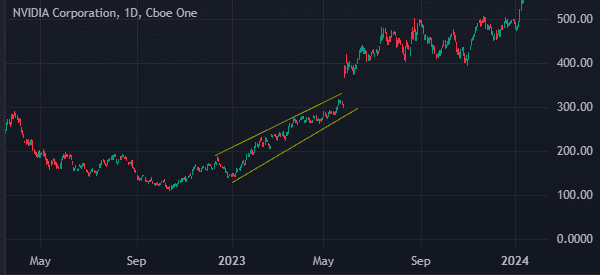
Identify reversals
Drawing tools, especially trendlines can be essential in identifying reversals. In the above example, we see that the stock has remained above the ascending channel.
A reversal would be signaled if the price moves below that support level. It would then be confirmed using a trend indicator like a moving average or Bollinger Bands.
Identify breakouts
The other benefit of drawing tools is that they help to identify or confirm breakouts. A breakout is a situation where an asset’s price in a consolidation suddenly rises or falls above or below a support level.
On the chart below, we see that the SPY ETF was in an uptrend since November 2023. As it rose, the fund found a strong resistance at $457.80, which coincided with the highest point in July. Therefore, a bullish breakout was confirmed when the price moved above this resistance level.
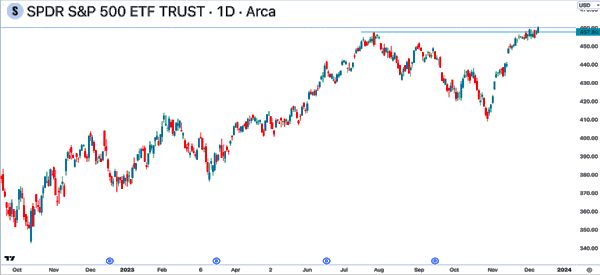
Identify support and resistance (S&R) levels
The other benefit of using drawing tools is that they can help you draw support and resistance levels easily. S&R are the most important levels in both trading and investing since they point to both continuation and reversals.
Some of the top tools that can help you in this are trendlines, Fibonacci Retracement, and Andrews pitchfork.
When to know the drawing tool to use
A common question is on when to know the best drawing tool to use when trading. The answer is that it depends on what is happening in the market. In some cases, such as during a ranging market, it is not ideal to use any drawing tools.
Tools like the Fibonacci Retracement and Andrews Pitchfork can be used well in a trending market. For this to happen, there needs to be well-defined swings in the asset. If you can’t find these swings are not available in a four-hour chart, you can expand it to a daily chart.
Horizontal lines are drawn when the price is moving in a horizontal direction such as when it is forming a rectangle pattern.
Limitations of drawing tools
While drawing tools are an important part of day trading, they have some limitations. First, these drawing tools might be impacted by the time frame used. For example, a stock might show a perfect Fibonacci Retracement in the daily chart and a different one on the four-hour chart.
Second, in most cases, drawing tools don’t tell the full story of an asset’s movement. As such, it makes sense to incorporate Fibonacci Retracement in trading. Third, these tools need to be confirmed using technical indicators.
External useful resources
- Complete list of Drawing tools in trading – Forextester





